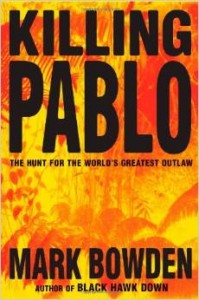 It’s been more two decades since Pablo Escobar’s reign of terror over the nation of Colombia ended, but travelers still encounter vestiges of the carnage. In Bogotá’s Museo Histórico Policia, for example, a whole section is dedicated to the hunt for and death of Escobar. You’ll see a roof tile stained with his blood, his solid gold glasses frames, and his gold and silver Harley-Davidson. As documented in Mark Bowden’s Killing Pablo: The Hunt for the World’s Greatest Outlaw (2001, ISBN 0-87113-783-6), Escobar was a master media manipulator, civic Robin Hood, cagey political animal, and public terrorist, all rolled into one.
It’s been more two decades since Pablo Escobar’s reign of terror over the nation of Colombia ended, but travelers still encounter vestiges of the carnage. In Bogotá’s Museo Histórico Policia, for example, a whole section is dedicated to the hunt for and death of Escobar. You’ll see a roof tile stained with his blood, his solid gold glasses frames, and his gold and silver Harley-Davidson. As documented in Mark Bowden’s Killing Pablo: The Hunt for the World’s Greatest Outlaw (2001, ISBN 0-87113-783-6), Escobar was a master media manipulator, civic Robin Hood, cagey political animal, and public terrorist, all rolled into one.
The book contains many fascinating elements, including his success in having government officials, police, and military all on his payroll. Threats to the families of these individuals guaranteed their loyalty and he carried out vengeance ruthlessly when he was not obeyed. The beginning of his undoing came when he sponsored the in-air explosion of an Avianca commercial flight, killing all 110 people on board, but not the intended victim, political candidate César Gaviria, who had purchased a ticket, but had not taken the flight. The job of hunting down Escobar finally fell to Colonel Hugo Martinez.
Eventually, a surrender was worked out and Escobar was exiled to his own comfortable prison, full of every imaginable creature comfort and an ongoing parade of guests. When the government started to build an additional perimeter fence, Escobar escaped. It wasn’t difficult, as he had corrupted virtually the entire guard force. Escobar’s strategy for pots-incarceration survival was a study in brinkmanship, and included setting off bombs in public places as well as assassinations of political leaders and media personnel. His undoing began with a secret vigilante force, “Los Pepes,” who destroyed his assets, kidnapped and murdered his associates and lawyers, and threatened immediate family members, outdoing him at his own game.
While careful not to draw conclusions without hard evidence, Bowden’s opinion is that Los Pepes couldn’t have done their handiwork without the knowledge of Martinez’s team, and in fact, probably included them. While this brought forth much hand-wringing on the part of both U.S. and Colombian officials, it was tacitly allowed to continue. Martinez force was incorruptible, and had learned to its dismay that every move that was conveyed to the police or military was immediately telegraphed to Escobar.
Eventually, Excobar tried to negotiate another surrender, with the stipulation that his wife and children be allowed to leave the country. But Martinez and his colleagues and associates, which by now included Colombia’s most powerful political and justice authorities, weren’t going to allow that to happen. Arriving in Germany, his family was turned back on the tarmac and returned to Colombia.
The final hunt for Escobar is detailed in wonderful cloak-and-dagger details. In a final coup de grâce, the kill team shaved off the ends of his moustache alà Hitler. The book remains a must for readers wishing a historical perspective on Colombia and the drug wars, and offers a fascinating glimpse into the life of one of the most intriguing criminals of the twentieth century. But this book now at the WoWasis eStore.
Leave a Reply